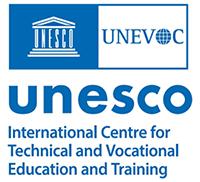
The UNESCO-UNEVOC International Centre: Who We Are | What We Do | Working With Us | Get in Touch
The UNEVOC Network: Learn About the Network | UNEVOC Network Directory
For Members: UNEVOC Centre Dashboard
Thematic Areas: Inclusion and Youth | Digital Transformation | Private Sector Engagement | SDGs and Greening TVET
Our Key Programmes & Projects: BILT: Bridging Innovation and Learning in TVET | Building TVET resilience | TVET Leadership Programme | WYSD: World Youth Skills Day
Past Activities: COVID-19 response | i-hubs project | TVET Global Forums | Virtual Conferences | YEM Knowledge Portal
Our Services & Resources: Publications | TVET Forum | TVET Country Profiles | TVETipedia Glossary | Innovative and Promising Practices | Toolkits for TVET Providers | Entrepreneurial Learning Guide
Events: Major TVET Events | UNEVOC Network News
Fundación Paraguaya is a self-sustainable, non-governmental organization. Since its foundation in 1985, it has spearheaded microfinance and entrepreneurship in Paraguay.
With more than 450 staff in 28 offices across the country, Fundación Paraguaya develops and implements practical, innovative, and sustainable solutions to eliminate poverty in order to create decent conditions for all families using four inter-related strategies:
The educational model we propose undertakes a different path in the struggle to eradicate poverty. We work with poor rural communities to transform their youth into rural entrepreneurs.
In addition to high quality education, self-sustainable productive business units, which cover 100% of the School’s operating costs, are incorporated. This model uses the “Learn by Doing, Selling and Earning” methodology that has a curriculum based on theory classes complemented by hands-on field practice.
With this innovative approach we seek to make a difference, and above all ensure that more youth at risk acquire the skills and knowledge necessary to begin their own rural enterprises, access a decent job in the agriculture/livestock sector or continue studying. Moreover, it is a school model that can be replicated anywhere in the world thanks to its social franchise based on entrepreneurship.
We are using our microfinance program to eliminate the poverty that affects the families of our more than 90,000 clients, from rural and urban areas. 86% of these clients are women. To do so, we have developed a practical methodology which, as a first step, allows poor families to self-diagnose their own poverty, and then permits to develop personalized strategies that help families to permanently pull themselves out of poverty. We call it the “Poverty Stoplight” approach created to eliminate multidimensional poverty.
This methodology makes poverty “visible” by dividing the model into 6 dimensions and 50 indicators, so that a poor person can visualize the ways in which poverty affects their own family. As the name suggests, our tool uses stoplight colors: Red (for Extremely Poor), Yellow (for Poor), Green (for Not Poor), as well as photographs, maps, tablets, and a visual survey to create innovative plans that enable the poor communities to better understand and visualize the ways in which they are affected by poverty.
We compete in the microfinance industry, however, unlike other microfinance entities, which only offer “financial inclusion”, our value proposition is – like Aladin- to unleash the “genie” within each family by giving them the tools and motivation to overcome their poverty. We are not seeking to alleviate, reduce or combat poverty; we plan to eliminate it! This innovative strategy makes us different.
We measure our impact by the number of families that overcome poverty every year thanks to our project. For example, in the last 3 years, we have enabled 16,000 families to overcome poverty with respect to their level of income, but what we really want is for microfinance institutions all over the world to adopt the Poverty Stoplight methodology. Latin America count up to more than 11 million clients of microfinance institutions. Therefore, we are working to create a better awareness and understanding of this methodology, so the microfinance institutions can adopt it and empower millions of families to overcome poverty all over the world.
Fundación Paraguaya envisions a world without poverty where we all want to live. Its mission is to Develop and implement practical, innovative and sustainable solutions that allow activating the entrepreneurial potential of families to eliminate their multidimensional poverty and live with dignity.

